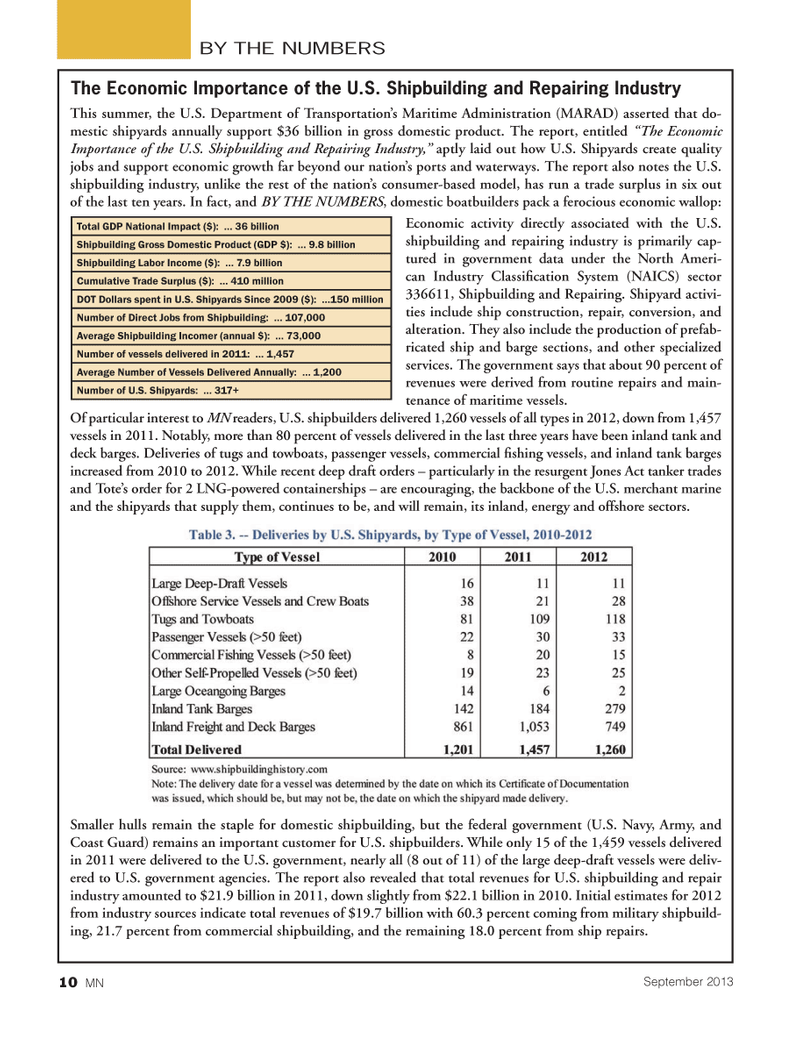
Page 10: of Marine News Magazine (September 2013)
Workboat Annual
Read this page in Pdf, Flash or Html5 edition of September 2013 Marine News Magazine
This summer, the U.S. Department of Transportations Maritime Administration (MARAD) asserted that do- mestic shipyards annually support $36 billion in gross domestic product. The report, entitled The Economic Importance of the U.S. Shipbuilding and Repairing Industry,? aptly laid out how U.S. Shipyards create quality jobs and support economic growth far beyond our nations ports and waterways. The report also notes the U.S. shipbuilding industry, unlike the rest of the nations consumer-based model, has run a trade surplus in six out of the last ten years. In fact, and BY THE NUMBERS , domestic boatbuilders pack a ferocious economic wallop: Economic activity directly associated with the U.S. shipbuilding and repairing industry is primarily cap- tured in government data under the North Ameri- can Industry Classi? cation System (NAICS) sector 336611, Shipbuilding and Repairing. Shipyard activi- ties include ship construction, repair, conversion, and alteration. They also include the production of prefab- ricated ship and barge sections, and other specialized services. The government says that about 90 percent of revenues were derived from routine repairs and main- tenance of maritime vessels. Of particular interest to MN readers, U.S. shipbuilders delivered 1,260 vessels of all types in 2012, down from 1,457 vessels in 2011. Notably, more than 80 percent of vessels delivered in the last three years have been inland tank and deck barges. Deliveries of tugs and towboats, passenger vessels, commercial ? shing vessels, and inland tank barges increased from 2010 to 2012. While recent deep draft orders ? particularly in the resurgent Jones Act tanker trades and Totes order for 2 LNG-powered containerships ? are encouraging, the backbone of the U.S. merchant marine and the shipyards that supply them, continues to be, and will remain, its inland, energy and offshore sectors. Smaller hulls remain the staple for domestic shipbuilding, but the federal government (U.S. Navy, Army, and Coast Guard) remains an important customer for U.S. shipbuilders. While only 15 of the 1,459 vessels delivered in 2011 were delivered to the U.S. government, nearly all (8 out of 11) of the large deep-draft vessels were deliv- ered to U.S. government agencies. The report also revealed that total revenues for U.S. shipbuilding and repair industry amounted to $21.9 billion in 2011, down slightly from $22.1 billion in 2010. Initial estimates for 2012 from industry sources indicate total revenues of $19.7 billion with 60.3 percent coming from military shipbuild- ing, 21.7 percent from commercial shipbuilding, and the remaining 18.0 percent from ship repairs. Total GDP National Impact ($): ? 36 billion Shipbuilding Gross Domestic Product (GDP $): ? 9.8 billion Shipbuilding Labor Income ($): ? 7.9 billion Cumulative Trade Surplus ($): ? 410 million DOT Dollars spent in U.S. Shipyards Since 2009 ($): ?150 million Number of Direct Jobs from Shipbuilding: ? 107,000 Average Shipbuilding Incomer (annual $): ? 73,000 Number of vessels delivered in 2011: ? 1,457 Average Number of Vessels Delivered Annually: ? 1,200 Number of U.S. Shipyards: ? 317+ BY THE NUMBERSThe Economic Importance of the U.S. Shipbuilding and Repairing Industry September 201310 MNMN Sept2013 Layout 1-17.indd 108/29/2013 11:09:29 AM

 9
9

 11
11
